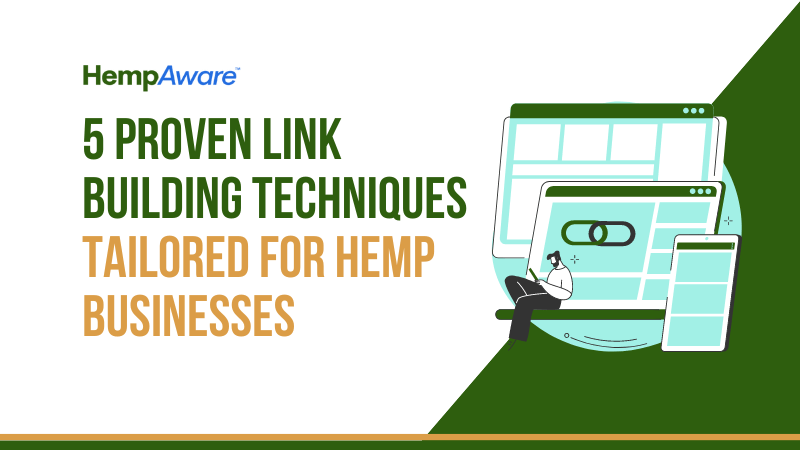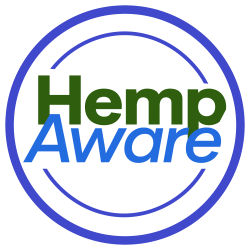Link building plays a vital role in the success of your hemp business, as it enables you to establish a strong online presence and attract targeted traffic to your hemp website.
In today’s digitally-focused world, having a well-structured and high-quality link profile is essential for enhancing search engine rankings and increasing organic visibility.
As a passionate advocate for hemp products, I have personally witnessed the transformative power of link-building for businesses in the hemp industry and our clients.
By strategically acquiring backlinks from reputable websites, hemp businesses can not only improve their website’s authority but also gain access to a wider audience that shares an interest in hemp products.
When it comes to link-building for hemp businesses, it’s important to adopt techniques that are tailored to the unique needs of this industry.
The legal restrictions and misconceptions surrounding hemp can pose specific challenges for link building, making it crucial to approach this process with care and creativity.
In my experience, one effective technique is to collaborate with influencers or bloggers who are passionate about hemp and natural wellness.
By providing them with high-quality content or product samples for review, you can generate valuable backlinks and tap into their engaged audience.
This not only improves your website’s visibility but also establishes your brand as a trusted authority in the hemp industry.
Link Building Can Help You Get More Traffic and Sales
Link building is an essential aspect of any successful SEO strategy – especially for hemp companies.
It plays a crucial role in driving organic traffic to your website and improving your search engine rankings.
According to some SEO experts, link building can contribute up to 25% or more of your overall SEO efforts.
When it comes to hemp businesses, implementing effective link-building techniques is even more important.
With the growing popularity of the hemp industry, competition is fierce, and standing out from the crowd is crucial for success.
By leveraging the power of link-building, hemp businesses can boost their online visibility, reach a wider audience, and establish authority in their niche.
5 Techniques to Build Links for Hemp Websites
So, what are some proven link-building techniques that can specifically benefit hemp businesses?
Let’s explore five strategies tailored to the unique needs of the hemp industry.
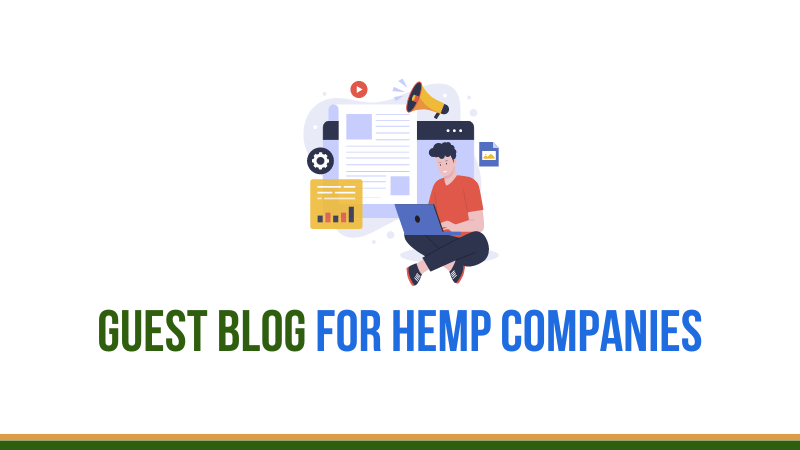
Technique 1: Guest Blogging
Guest blogging is a content marketing strategy where an individual or company writes and publishes an article on another website.
In the context of helping hemp companies, guest blogging involves creating high-quality content related to hemp, CBD, or other relevant topics and submitting them to websites in the same niche, or similar niches that would benefit from your content.
Benefits of guest blogging for link-building for hemp companies:
1. Building backlinks:
Guest blogging allows you to include links within your article, usually in the author bio or within the content itself.
By including relevant links to your hemp company’s website, you can increase its visibility and authority in search engine rankings.
2. Increased brand exposure:
Publishing articles on other websites exposes your brand and expertise to a wider audience.
It helps in building brand recognition and establishing credibility within the hemp industry.
3. Targeted traffic:
When you write guest posts for websites that are already attracting your target audience, you can drive targeted traffic to your hemp company’s website.
This can lead to increased conversions, sales, and potential partnerships within the industry.
4. Networking opportunities:
Guest blogging opens doors for collaboration and networking in the hemp industry.
It allows you to connect with other industry professionals, influencers, or potential customers, which can further boost your company’s growth and reputation.
5. Enhancing SEO:
Guest blogging contributes to improving your search engine optimization efforts.
By incorporating relevant keywords and providing valuable content, you can enhance your website’s visibility in search engines and potentially improve its ranking.
It’s important to note that successful guest blogging requires researching and identifying reputable hemp-related websites, creating high-quality and relevant content, and following their guidelines for submissions.
Additionally, building relationships with website owners or editors is essential to increase the chances of getting published and maximizing the benefits of guest blogging.
5 Tips for Writing High-Quality Guest Posts that Attract Backlinks
By pitching your ideas and contributing valuable content, you can establish yourself as an authority in the hemp industry and attract more traffic to your website.
1. Research and Identify Relevant Hemp Blogs:
Start by researching blogs that focus on hemp, health, or related topics.
Look for blogs with a strong readership and engagement from the target audience.
Some popular options include hemp lifestyle blogs, CBD product review blogs, and holistic health websites.
Make a list of potential blogs that align with your business goals.
2. Craft Compelling Guest Post Ideas:
Once you have identified the blogs, it’s time to come up with compelling guest post ideas. Consider topics that are informative, engaging, and offer value to the readers.
For example, you could write about the benefits of using hemp products for skincare, the latest trends in the hemp industry, or share success stories of businesses that have thrived in the hemp market.
3. Customize Your Pitch:
When reaching out to blog owners or editors, personalize your pitch to increase the chances of acceptance.
Show that you have done your homework by mentioning specific articles or topics on their blog that you found interesting.
Explain why your post would be a great fit for their audience and how it can bring value to their readers.
4. Create High-Quality Content:
Once your guest post ideas are approved, it’s crucial to create high-quality content. Research the topic thoroughly, provide accurate information, and use credible sources to back up your claims. Craft an engaging headline and structure your post in a way that is easy to read and understand. Include relevant images, infographics, or videos to enhance the visual appeal.
5. Promote Your Guest Post:
After your guest post is published, don’t just sit back and wait for the readers to come.
Take an active role in promoting your content.
Share the post on your social media platforms, email it to your subscribers, and encourage your network to share it with their audience.
Engage with readers by responding to comments and questions, and build relationships within the blogging community.
Remember, guest posting is not just about building backlinks, but also about building relationships and providing value to the readers.
So, put your expertise to work and start pitching your guest post ideas today!

Technique 2: Influencer Outreach
Collaborating with influencers in the hemp industry is crucial for link-building for several reasons.
Firstly, influencers have a dedicated and engaged following, which can result in increased visibility and traffic to your website.
When influencers incorporate links to your website in their content, it helps to establish valuable backlinks that can improve your search engine rankings.
Additionally, influencers’ credibility and authority within the industry can enhance your brand’s reputation and trustworthiness.
By collaborating with influencers, you can tap into their existing networks and reach a wider audience, creating opportunities for brand exposure and potential customer acquisition, leading to more sales and money in your bank account.
Overall, influencer collaborations provide a powerful link-building strategy that can significantly boost your online presence and drive organic traffic to your hemp website.
3 Strategies for finding and reaching out to relevant influencers
Identify Target Audience:
Understand your target audience and their preferences.
Research and identify influencers who have a strong following within the hemp or health-related niche.
Look for influencers who align with your brand values and have an engaged audience.
Utilize Social Media Platforms:
Utilize platforms like Instagram, YouTube, and TikTok to find relevant influencers.
Use hashtags and keywords related to hemp and health to discover influencers who are already creating content in your niche.
Pay attention to their follower count, engagement rates, and the quality of their content.
Personalized Outreach:
Once you’ve identified potential influencers, reach out to them with a personalized message explaining why you believe they would be a good fit for your brand.
Offer them incentives such as free products, exclusive discounts, or collaboration opportunities.
Make sure to establish a genuine connection and highlight how their partnership can benefit both parties, but mainly focus on how it can help them and their audience.

Technique 3: Local SEO and Directory Listings
Local SEO is of great significance for hemp businesses as it helps them target their local customer base effectively. It can also help you to get out in the real world and rub shoulder-to-shoulder with actual people in the flesh.
With the increasing demand for hemp products, it is crucial to optimize online presence for local searches.
Local SEO strategies such as optimizing Google My Business profile, creating location-specific landing pages, and incorporating relevant keywords can ensure higher visibility in local search results.
This is particularly valuable for hemp businesses as they often operate within legal restrictions and specific regulations that vary by location.
Local SEO helps hemp businesses connect with potential customers searching for hemp-related products or services in their area, increasing foot traffic to physical stores, and driving online sales.
It allows businesses to establish themselves as local authorities in the hemp industry, build trust, and foster a loyal customer base within their community.
3 Tips for Optimizing Business Listings on Online Directories
Tip 1: Consistency is Key:
Ensure that your business information otherwise known as your N.A.P. (name, address, phone number, website URL) is consistent across all online directories.
Inconsistencies can confuse search engines and potential customers.
Regularly check and update your listings to reflect any changes to your business information.
Tip 2: Include Relevant Keywords:
Incorporate relevant keywords related to your hemp business in the business description, title, and tags.
This will help search engines understand the nature of your business and improve your visibility in search results.
Tip 3: Encourage Reviews:
Positive reviews play a crucial role in attracting customers.
Encourage satisfied customers to leave reviews on online directories.
Respond promptly and professionally to all reviews, whether positive or negative.
This shows potential customers that you value feedback and are committed to providing a positive customer experience.
Additionally, search engines consider reviews as a ranking signal, so having a high number of positive reviews can improve your visibility in search results.
Final thoughts on getting Backlinks via Online Directories
Obtaining backlinks from local directories and listings is highly valuable for hemp companies.
Local directories and listings are trusted sources of information for search engines, and having backlinks from these reputable sources can significantly boost your website’s authority and visibility in local search results.
Backlinks from local directories help search engines understand the relevance and credibility of your hemp business in specific geographic areas, making it easier for potential customers to find you.
Additionally, these backlinks can drive direct referral traffic to your website from users browsing local directories for hemp-related products or services.
Furthermore, backlinks from local directories and listings can improve your local SEO efforts by signaling to search engines that your business is actively involved in the local community.
This can lead to higher search rankings, increased organic traffic, and ultimately, more conversions and sales for your hemp business.
Therefore, investing time and effort into obtaining backlinks from local directories is an essential aspect of your overall marketing strategy.
If you want access to our custom tool to help you keep your NAP info consistent and up to date on the most popular online directories, set up a call with one of our hemp marketing experts right now.
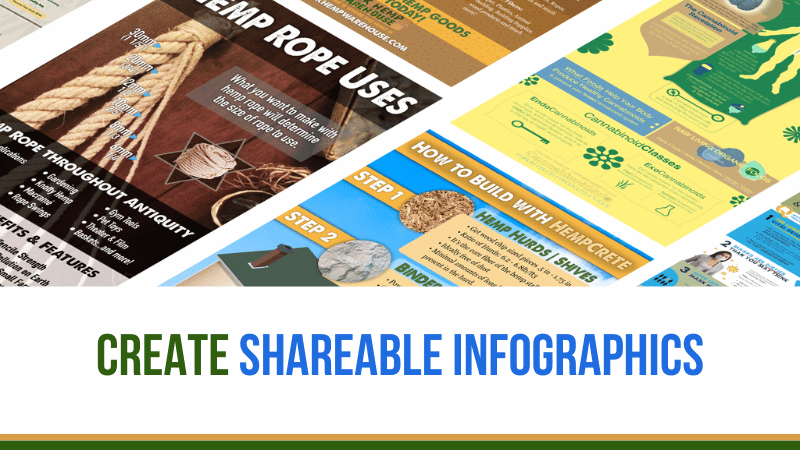
Technique 4: Creating Shareable Infographics
Creating shareable infographics is crucial for hemp companies as they have the potential to attract a large number of backlinks.
Infographics are visually appealing and present information in a concise and engaging manner.
When shared on social media platforms, websites, or blogs, they are more likely to be linked to and shared by others.
This not only increases the visibility of your brand but also generates valuable backlinks from authoritative sources.
Backlinks from reputable websites enhance your website’s credibility, improve search engine rankings, and drive organic traffic.
Infographics are an effective way to showcase your expertise, educate your audience, and encourage others to share and link to your content, making them an invaluable tool for building backlinks for hemp companies.
Top 5 Benefits of using infographics to attract backlinks
Using infographics to attract backlinks for hemp businesses offers several key benefits:
1. Visual Appeal:
Infographics are visually attractive and easily grab attention.
Their combination of engaging design elements, colors, and images makes them more likely to be shared and linked to by other websites, blogs, and social media users.
2. Increased Sharability:
Infographics are highly shareable content.
People often share infographics on their websites, blogs, and social media platforms to provide value to their audience.
This increases the likelihood of gaining backlinks as more people discover and reference your infographic.
3. Enhanced Link Building:
Infographics are an effective link building tool.
When others find your infographic valuable, they are more likely to link back to it as a reference or as a visual aid to support their content.
These backlinks from reputable sources boost your website’s authority, search engine rankings, and organic traffic.
4. Demonstrating Expertise:
Creating hemp infographics allows you to showcase your expertise and knowledge in the hemp industry.
By presenting complex information in a visually appealing and easy-to-understand format, infographics position your brand as a trusted source of information.
This can attract backlinks from authoritative websites and industry influencers who recognize your expertise and want to share valuable content with their audience.
5. Increased Brand Awareness:
Creating and distributing infographics helps increase brand awareness for your hemp business.
When your infographics are shared and linked to by others, it exposes your brand to a wider audience who may not have been previously aware of your business.
This can lead to increased brand recognition, website visits, and potential customers.
Infographics have the power to capture attention, educate, and inspire others to engage with your brand, making them a valuable tool for attracting backlinks and driving success for your hemp business.
8 Steps for Designing and Creating Compelling Hemp Infographics
Designing and creating compelling infographics involves several key steps:
Step 1 Define the Objective:
Start by identifying the purpose and objective of your infographic.
Determine what message or information you want to convey and who your target audience is.
This will guide the content and design decisions throughout the process.
Step 2 Research and Gather Data:
Conduct thorough research to gather accurate and relevant data, statistics, or facts that support the main message of your infographic.
Ensure that the information comes from credible sources.
Step 3 Plan the Structure:
Determine the flow and structure of your infographic.
Create a logical sequence that leads the viewer through the information in a clear and engaging way.
Use headings, subheadings, and bullet points to organize the content.
Step 4 Design Elements:
Choose a visually appealing color scheme that aligns with your brand.
Use icons, illustrations, and eye-catching visuals to enhance the design and make the information more engaging.
Keep the design clean, uncluttered, and easy to follow.
Incorporate whitespace to improve readability.
Step 5 Use Charts and Graphs:
Present data in a visual format using charts, graphs, or diagrams.
This helps to simplify complex information and makes it easier for viewers to understand and interpret the data.
Step 6 Add Captions and Text:
Include concise and informative captions or text to provide context and explain the main points of each section.
Use a clear and legible font that is easy to read.
Step 7 Review and Edit:
Double-check the accuracy of the information and review the infographic for any errors or inconsistencies.
Ensure that the design elements are visually appealing and aligned with the overall objective of the infographic.
Step 8 Share and Promote:
Once your infographic is finalized, it’s time to share and promote it.
Publish it on your website or blog, and share it across your social media channels. Encourage others to share it as well by including social sharing buttons.
Reach out to relevant industry websites or blogs and offer your infographic as a valuable resource that they can feature and link to.
Consider submitting it to infographic directories or platforms to increase its visibility.
Lastly, track the performance of your infographic by monitoring metrics such as shares, backlinks, and engagement to gauge its success and make improvements for future infographics.
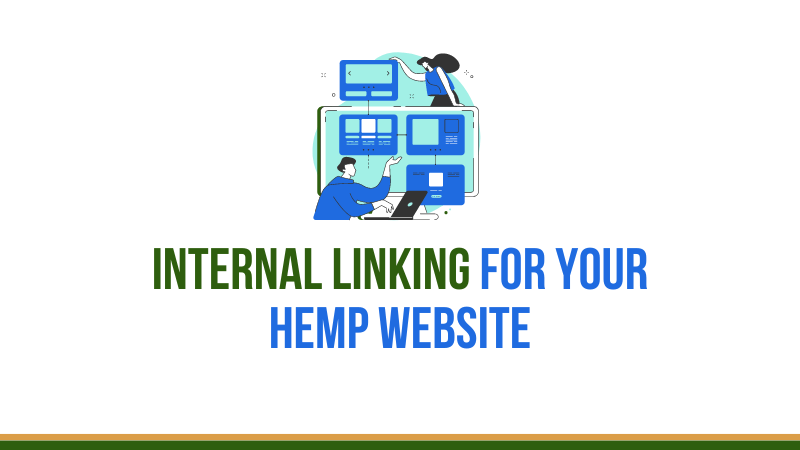
Technique 5: Don’t Underestimate the Power of Internal Linking for Your Hemp Website
When it comes to optimizing your hemp website for search engines and improving user experience, internal linking plays a crucial role that should not be underestimated.
Internal linking refers to the practice of linking one page of your website to another page within the same domain.
Here are some key reasons why internal linking is important for your hemp website:
Enhances Website Navigation:
Internal links help users navigate your website more easily.
By strategically placing internal links within your content, you guide visitors to related or relevant pages, allowing them to explore more of your hemp products, services, or educational resources.
This not only improves user experience but also encourages visitors to stay on your website for longer periods, reducing bounce rates.
Boosts SEO Performance:
Internal linking is a powerful SEO strategy.
When search engines crawl your website, they follow internal links to discover and index new pages.
By interlinking relevant pages with targeted anchor texts, you can indicate to search engines the importance and relationships between different pages on your hemp website.
This helps search engines understand the structure and hierarchy of your website, ultimately improving your website’s visibility in search engine results pages (SERPs).
Additionally, internal linking distributes the authority or “link juice” from high-ranking pages to others, boosting their chances of ranking higher in search results.
Increases Keyword Relevance:
Internal linking allows you to leverage your target keywords effectively.
By linking relevant pages using keyword-rich anchor text, you signal to search engines the relevance and context of the linked page.
This can improve your website’s keyword rankings and increase organic traffic to those specific pages.
Encourages Content Discoverability:
Internal linking helps ensure that your valuable hemp-related content gets the attention it deserves.
By linking to older or lesser-known content from newer or more popular pages, you give exposure to your underperforming content.
This improves its visibility and increases the chances of it being discovered by users.
It also helps in distributing traffic evenly across your website, preventing certain pages from being overlooked.
Facilitates Website Updates and Maintenance:
Internal linking is especially useful when you make updates or changes to your hemp website.
If you create a new product page or publish a fresh blog post, you can link it to relevant existing pages to establish connections and provide additional context.
This makes it easier for both users and search engines to navigate through your updated website structure.
In conclusion, internal linking is a powerful tool that should not be underestimated when it comes to optimizing your hemp website.
By strategically incorporating internal links, you can enhance navigation, improve SEO performance, increase keyword relevance, boost content discoverability, and facilitate website updates.
So, make sure to implement a thoughtful internal linking strategy to maximize the potential of your hemp website and provide a seamless user experience.
Final Thoughts on Your Link Building Strategy for Your Hemp Website
Certainly! Here are a few closing paragraphs that recap the link-building techniques, emphasize their long-term benefits, and encourage implementation and monitoring of their impact:
In summary, the journey to enhancing your hemp business’s digital footprint involves five key link-building techniques: Guest Blogging, Influencer Outreach, Local SEO and Directory Listings, Creating Shareable Infographics, and the Power of Internal Linking.
Each of these strategies offers a unique pathway to elevate your website’s authority and visibility in the ever-competitive online landscape.
Guest blogging opens doors to new audiences and establishes your expertise, while influencer outreach leverages the credibility and reach of industry thought leaders.
Local SEO and directory listings ensure your business stands out in local searches, a critical factor given the unique regulatory landscape of the hemp industry.
Shareable infographics not only engage your audience visually but also enhance shareability, driving organic backlinks.
Lastly, internal linking within your own website fortifies the SEO structure, guiding visitors to relevant content and improving overall site engagement.
The long-term benefits of these link-building strategies cannot be overstated.
Consistently applying these techniques will not only improve your search engine rankings but also solidify your brand’s reputation and authority in the hemp market.
Enhanced visibility translates to increased website traffic, higher engagement rates, and, ultimately, a significant boost in sales and customer loyalty.
We strongly encourage hemp businesses to implement these link-building strategies with a dedicated focus and regular monitoring.
Tracking their impact on website traffic and search engine rankings will provide valuable insights into the effectiveness of your efforts.
Remember, the digital landscape is dynamic, and staying adaptable in your strategies is key to long-term success.
Implement, monitor, adapt, and watch your hemp business thrive in the digital realm.
By the way, if you need help with your link building strategy and don’t want to do all the work, let our team of Hemp SEO experts help you get the results you deserve.

